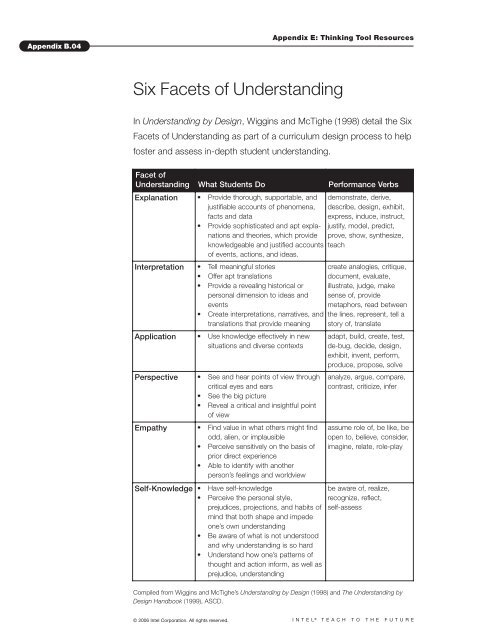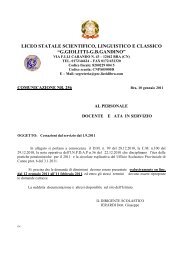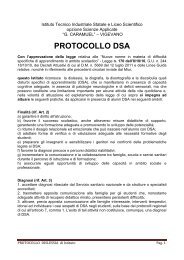Bloom's Taxonomy: Categories in the Cognitive ... - Licei di Bra
Bloom's Taxonomy: Categories in the Cognitive ... - Licei di Bra
Bloom's Taxonomy: Categories in the Cognitive ... - Licei di Bra
Create successful ePaper yourself
Turn your PDF publications into a flip-book with our unique Google optimized e-Paper software.
Appen<strong>di</strong>x B.04Appen<strong>di</strong>x E: Th<strong>in</strong>k<strong>in</strong>g Tool ResourcesSix Facets of Understand<strong>in</strong>gIn Understand<strong>in</strong>g by Design, Wigg<strong>in</strong>s and McTighe (1998) detail <strong>the</strong> SixFacets of Understand<strong>in</strong>g as part of a curriculum design process to helpfoster and assess <strong>in</strong>-depth student understand<strong>in</strong>g.Facet ofUnderstand<strong>in</strong>g What Students Do Performance VerbsExplanation • Provide thorough, supportable, andjustifiable accounts of phenomena,facts and data• Provide sophisticated and apt explanationsand <strong>the</strong>ories, which provideknowledgeable and justified accountsof events, actions, and ideas.Interpretation • Tell mean<strong>in</strong>gful stories• Offer apt translations• Provide a reveal<strong>in</strong>g historical orpersonal <strong>di</strong>mension to ideas andevents• Create <strong>in</strong>terpretations, narratives, andtranslations that provide mean<strong>in</strong>gApplication • Use knowledge effectively <strong>in</strong> newsituations and <strong>di</strong>verse contextsPerspective • See and hear po<strong>in</strong>ts of view throughcritical eyes and ears• See <strong>the</strong> big picture• Reveal a critical and <strong>in</strong>sightful po<strong>in</strong>tof viewEmpathy • F<strong>in</strong>d value <strong>in</strong> what o<strong>the</strong>rs might f<strong>in</strong>dodd, alien, or implausible• Perceive sensitively on <strong>the</strong> basis ofprior <strong>di</strong>rect experience• Able to identify with ano<strong>the</strong>rperson’s feel<strong>in</strong>gs and worldviewSelf-Knowledge • Have self-knowledge• Perceive <strong>the</strong> personal style,preju<strong>di</strong>ces, projections, and habits ofm<strong>in</strong>d that both shape and impedeone’s own understand<strong>in</strong>g• Be aware of what is not understoodand why understand<strong>in</strong>g is so hard• Understand how one’s patterns ofthought and action <strong>in</strong>form, as well aspreju<strong>di</strong>ce, understand<strong>in</strong>gdemonstrate, derive,describe, design, exhibit,express, <strong>in</strong>duce, <strong>in</strong>struct,justify, model, pre<strong>di</strong>ct,prove, show, syn<strong>the</strong>size,teachcreate analogies, critique,document, evaluate,illustrate, judge, makesense of, providemetaphors, read between<strong>the</strong> l<strong>in</strong>es, represent, tell astory of, translateadapt, build, create, test,de-bug, decide, design,exhibit, <strong>in</strong>vent, perform,produce, propose, solveanalyze, argue, compare,contrast, criticize, <strong>in</strong>ferassume role of, be like, beopen to, believe, consider,imag<strong>in</strong>e, relate, role-playbe aware of, realize,recognize, reflect,self-assessCompiled from Wigg<strong>in</strong>s and McTighe’s Understand<strong>in</strong>g by Design (1998) and The Understand<strong>in</strong>g byDesign Handbook (1999), ASCD.© 2006 Intel Corporation. All rights reserved.INTEL ®TEACH TO THE FUTURE
















